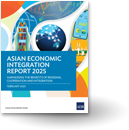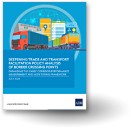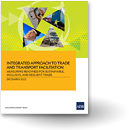Asian Trade Has Rebounded Strongly, Yet Uncertainties Persist
These charts illustrate the strong momentum of Asia’s trade growth during 2021, showing its resilience amid continuing uncertainties around the pandemic and a potential slowdown in the pace of global economic recovery.
Trade – in the form of merchandise trade – has improved markedly since the latter half of 2020 along with cross-border investment, capital flows, and international remittances. But trade in services, particularly non-digital services, and movement of people is still sluggish due to the ongoing pandemic. The emergence of new COVID-19 variants has hit trade particularly hard.
Although ramped up across the region and elsewhere, the varying progress of vaccination underlies the uneven pace of recovery in cross-border transactions, investments, and movement of people.
Though fitful, the trendline toward recovery is clear, and helped by the fact that Asia and the Pacific sustained strong intraregional trade links during the pandemic. Intraregional trade share rose to 58.5% in 2020, the highest level in three decades, from 57.5% in 2019. This expansion has been bolstered by deepening regional value chains and has been undeterred by the pandemic. The People’s Republic of China has also played a key role as the region’s major trading partner.
Trading within Asia and the Pacific has expanded across all subregions during the pandemic. South Asia’s share of trade within the region grew to 40.5% in 2020 from 38.9% in 2019. East Asian economies’ trade within Asia and the Pacific also strengthened, to 56.8% from 55.7%.
Intraregional trade for the Pacific and Oceania region increased to 72.6% from 72.0%. Central Asia’s intraregional trade share expanded to 36.8% from 36.0%, and Southeast Asia’s rose to 69.0% from 68.5%.
Sustained economic recovery after COVID-19 requires further cooperation across the region particularly through information sharing and other health control measures such as cross-border travel requirements and vaccinated travel lanes, to prevent flare-ups that could derail recovery.
Supply chain bottlenecks and growing global inflationary pressures call for closer collaboration among the region’s economies for cross-border movement of goods, services, and people. While the Regional Comprehensive Economic Partnership is a crucial milestone in leveling up the region’s concerted efforts for freer trade and investment flows, stronger cooperation and collaboration are also needed in disaster preparedness and response, climate change mitigation and adaptation, labor mobility and facilitation of travel and tourism, among others.
The region’s social and economic prospects will be significantly affected by how well it translates ongoing pandemic challenges into opportunities to forge closer economic relations and cooperation.
Original article was published at the Asian Development Blog and duplicated here with permission from the authors. *




